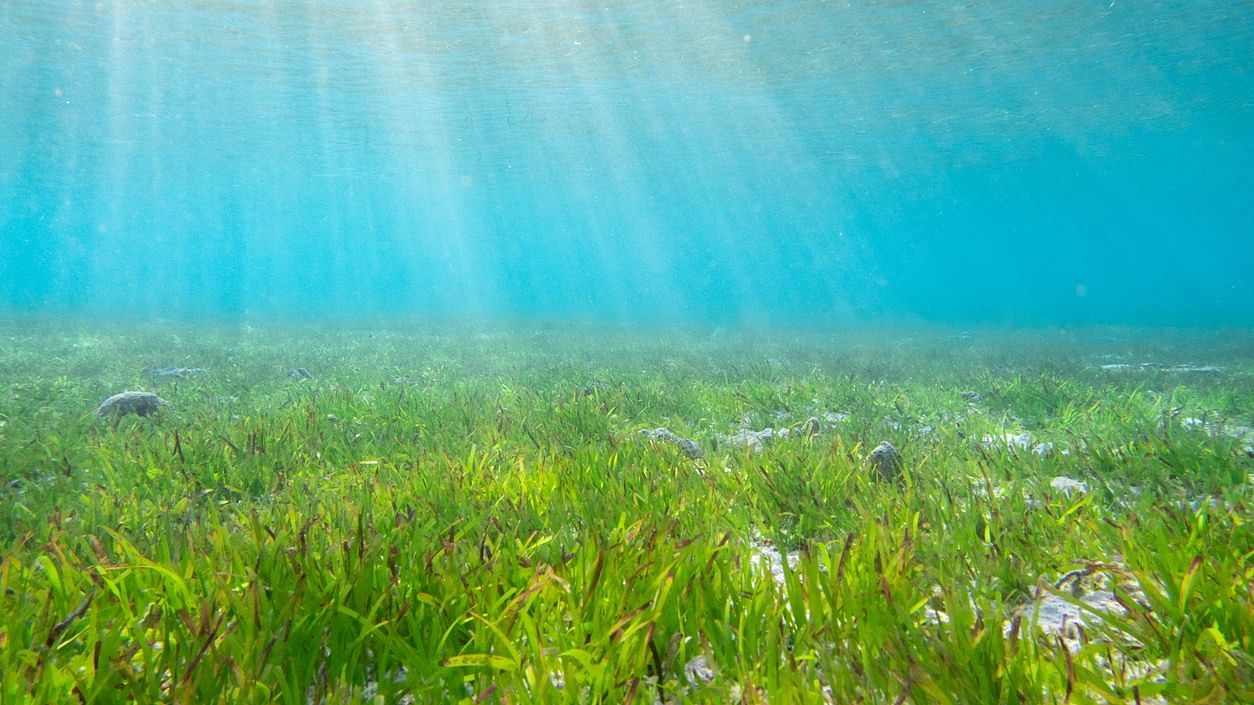
Image for representation showing seagrass.
Credit: iStock Photo
Chennai: Indiscriminate use of fishing trawlers in the shallow waters off Tamil Nadu coast has not only resulted in degradation and loss of seagrass over the decades in the ecologically sensitive Gulf of Mannar, but has also put marine species like the sea cow (dugong) and green turtle under threat.
With seagrass serving as one of the three major stocks of blue carbon, the Tamil Nadu government has decided to restore 15 acres of degraded seagrass and new seagrass meadows along the coast of the Gulf of Mannar.
The project, which will cover 5 acres each in Thoothukudi, Keelakarai, and Mandapam regions in Thoothukudi and Ramanathapuram districts, is aimed at rehabilitating the vital ecosystems by implementing seagrass plantations using shoots collected from nearby healthy seagrass beds.
Seagrass meadows provide vital habitats for a diverse range of marine organisms, serving as a critical feeding ground for dugong and green turtles and they are under threat primarily due to human activities such as boat traffic in shallow water.
Restoration of seagrass meadows will enhance their capacity for carbon storage and provide improved habitats for marine life, officials with the Forest Department said, adding that the activity will contribute to the overall sustainability of the coastal and marine environment in Tamil Nadu.
Gulf of Mannar, a Marine Biosphere Reserve which runs down south from Rameswaram to Kanyakumari in Tamil Nadu, encompasses a chain of 21 islands and adjoining coral reefs off the coasts of the Ramanathapuram and Thoothukudi districts forming the core zone.
Bottom trawlers, the fishing method used by fishermen in Tamil Nadu, have been a major source of friction between fishers from India and Sri Lanka as they scrap through the sea bed, severely damaging marine ecology. Lack of fish on the Indian side forces fishermen to cross into Sri Lankan waters but the fishers in the island nation object to use of trawlers due to their ecological destructive nature.
The project will include restoration of sites based on assessments of seagrass cover, shoot density, macrofauna density, and fish density. The average percentage of sea grass cover in Gulf of Mannar is 43 per cent and the average shoot density is 241.1 M², while it is just 37.6 per cent and is 181.1 M² in Ramanathapuram and less than 20 per cent in Thoothukudi, Pamban, and Dhanushkodi.
D Manikandavelu, retired professor, Department of Aquatic Environment Management, Dr J Jayalalithaa Fisheries University, Nagapattinam told DH that trawlers sweep through the bottom of the sea bed, leaving no room for benthos to exist. Restoration of seagrass, according to him, will serve as hideouts for many marine organisms and help in feeding and breeding.
“Seagrass is very important for marine species like dugong. Restoration of seagrass will not just increase the population of dugongs in the future but will also lead to increase in marine resources like shrimps and other invertebrates proportionately. It will also help protect vulnerable ecosystems and species, offering safe feeding and breeding niches” he said.
Dr V Deepak Samuel V, Scientist, National Centre for Sustainable Coastal Management, Chennai, told DH that seagrass not just provide tasty food for dugong, sea turtles, and other microorganisms, but also serve as a sediment trapper and minimise the flow of sea currents.
“Seagrass along with mangroves and salt marsh serve as three major stocks of blue carbon and protecting the diversity of flora is very important. Seagrass also provides the habitat for seahorses,” the scientist said.
Samuel also said the Gulf of Mannar has about 14 species and several micro and niche organisms besides sea cow and green turtle. “The restoration should be done after a detailed study on identifying the degraded areas. They shouldn’t trespass into other ecologically sensitive areas. Restoring seagrass is important to protecting and conserving associated biodiversity,” he added.